St. John’s location in the Caribbean, a meeting place between North and South America, has blessed it with thousands of species of flowers, trees, bushes, and plants. These are all the types of flora that call St John their home.
ACACIA (Acacia macracantha)
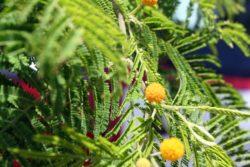
The acacia, also known locally as casha or casha bush, is protected from grazing animals by its long, sharp spines. Animals do, however, enjoy the seedpods and spread them out with their droppings. The acacia wood is very hard and is an excellent tree for making charcoal.
Aloe (Acacia macracantha)
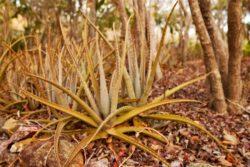
Amarat
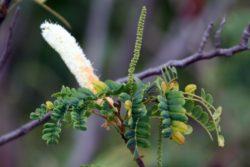
The amarat, Acacia muricata, is a wild native hardwood commonly found in dry forest environments on St. John. Although a member of the Acacia family, like the “casha tree” the amarat is does not have the characteristic long spines often found in other acacias.
Anthuriums (Araceae)
Anthuriums can grow on the ground, on rocks, or up in trees. The local varieties are Anthurium cordatum (heartleaf) and Anthurium crenatum (scrub brush).
The heartleaf is more common in moist forest areas. It produces beautiful foliage that sometimes is home for tree snails and nests of wasps called Jack Spaniards. The heartleaf anthurium produces a long pointy reddish-green stalk-like flower.
The scrub brush anthurium has long green leaves with seasonal red fruit. The dried dead leaves have been used in the past to scrub pots and pans. They are just as effective as the commercial pot scrubbing products used today, plus they have the advantage of being easily disposable, non-rusting and biodegradable.
The heartleaf anthurium is common in the Lesser Antilles. The scrub brush anthurium is found in the Greater Antilles. They seem to have met on the islands of St. John and Tortola to produce a hybrid variety (anthurium selloum) which is only found on these two islands.
It’s sterile and cannot reproduce. The hybrid is said to look just like what you would expect a mixture of the two parent varieties to look like. I’ve never seen one, see if you can identify one.
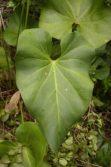
Bamboo
Bamboo is technically a grass, it grows rapidly and is extremely strong and durable. On St. John, there is a bamboo forest located just off Centerline Road in the vicinity of Cathrineberg.
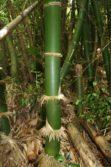
Bananas
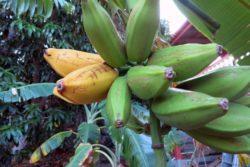
Baobob
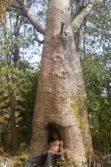
The only baobob tree on St. John can be found at Estate Sieban, which can be accessed via the L’Esperance Trail.
In many parts of Africa, the baobob tree is thought to be sacred and magical. The first seeds from these trees were brought to the Caribbean by enslaved Africans. Although there is only one baobob on St. John, St. Croix has more baobob trees than any other island in the Caribbean.
The seed pods are edible. They are filled with a dry powder tasting something like a sweet tamarind. They develop between February and June
The Baobob has also been called Guinea Almond on St. Croix and Guinea Tamarind on St. Thomas. The large white flowers open at night and are fertilized by bats.
Bay Rum
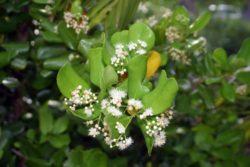
Bay rum is made using oil extracted from the leaves of the West Indian bay tree, Pinenta racemosa. Here on St. John the tree itself is called bay rum and it grows all over the island except on the East End and the in dry southwest corner. Especially prolific stands can be found on Bordeaux Mountain andin the Cinnamon Bay Valley. It is also known as bay, cinnamon and Cinnamon Bay and in the Patois spoken down island, it is called Bois d’Inde, or Tree from India.
St. John is reputed to have the finest bay rum trees in the world. According to the Encyclopedia Britannica, “the word ‘St. John’ on Bay Rum is like ‘Sterling’ on Silverware. It stands for the best in the world. This superiority is due to a special quality of the leaves of the Bay Trees, which grow on the island of St. John, and in no other part of the world.”
The first long-term European settlers of St. John were so impressed by the magnificence of the bay rum trees they encountered while exploring the north shore that they named two beautiful valleys after the tree, Cinnamon Bay, which was originally called Caneel Bay, Caneel being the Dutch word for cinnamon, and Caneel Bay, which was originally called Klein Caneel or Little Cinnamon.
The bay rum industry on St. John enjoyed some limited success for a while. Many of the new owners of the sugar estates converted their unused rum stills to accommodate the distillation of bay rum, an excellent example of which can be seen along the Loop Trail at Cinnamon Bay.
Beach Maho
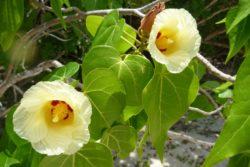
The beach maho is a tree commonly found on the St. John shoreline and throughout the tropics. It has a distinctive heart-shaped leaf and produces attractive yellow flowers that later turn purple. The small green fruit of the maho is not edible, but a bush tea can be made from the leaf.
Breadfruit
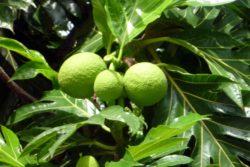
Breadfruit (Artocarpus altilis) trees are some of the largest trees found in the Virgin Islands and can reach heights of more than 80 feet.
The fruit can be roasted baked, fried or boiled and tastes a lot like fresh-baked bread.
Breadfruit first arrived in the Caribbean in1791, brought to Jamaica by Captain William Bligh of “Mutiny on the Bounty” fame.
Bromeliad
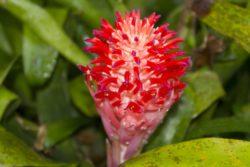
Cactus
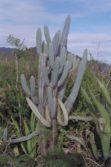
This tall light green cactus branches at the base and has vertical stems. The spines grow in long rows and are extremely formidable. They can pierce clothing and light footwear such as sneakers or sandals. It is also known a didildo or dildo cactus.
Some birds make their nests using the spines for support and protection against enemies.
Barrel Cactus
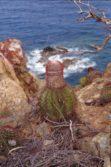
Also called Turk’s Head,, Pope’s Head or Compass Plant (because they tend to tilt toward the south). They are round or barrel-shaped and can grow in hard, rocky, windswept, and sun-drenched environments where little else can survive. The small pink fruit is edible.
Paddle Cactus
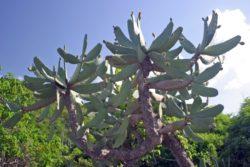
Opuntia ficus-indica, locally called paddle cactus, prickly pear and nopal can be found on St. John cactus scrub lands. The fleshy paddles are edible once the spines are removed and are used in salads, soups and desserts.
Sucker
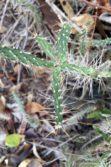
Opuntia repens and Acacia westiana lie low on the ground and are known locally as suckers. The spines can be quite painful and hard to dislodge if you get stuck.
Calabash
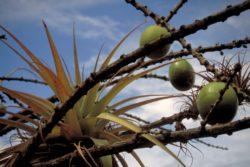
Calabash trees are often planted as ornamentals or for their large fruit which can be dried and used for bowls, water jugs or musical instruments.
A native of Africa, the calabash may have arrived on St. John with the slaves who worked on the Virgin Islands sugar plantations.
Catch ‘n’ Keep (Acacia riparia)
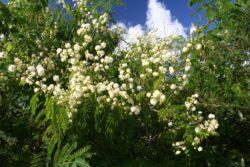
Riparia is a good name for the thorny vine that tends to rip your clothes when you walk past it. Catch-and-keep has sharp barbed hooked spines on its stem and leaves that can readily catch onto clothing or skin and be reluctant to let go, catching you and keeping you caught.
Century Plant (Agave missionum)
Although many Virgin Islanders now purchase imported pine trees from North America to use as Christmas trees, the traditional Virgin Island Christmas tree is made from the stalk of the mature century plant.
Here on St. John, the main use of the century plant stalk is for the traditional Christmas tree of the Virgin Islands. In December islanders search the bush for the mature century plant. The stalk is cut down with a machete and brought home where it is painted and supported in a bucket filled with rocks. Ornaments and lights may then be hung from the branches, and the end result is a wonderful and less expensive alternativeto the imported North American pine.
The century plant, Agave missionum, is a common sight in St. John, especially in the drier areas of the island.
Cacao Treecacao
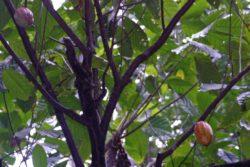
The cacao or chocolate tree, Theobroma cacao, is a native of the Americas.It is an evergreen tree that can grow to about twenty five feet in height and six inches in trunk diameter. It is usually cultivated under larger shade trees. In the large five celled fruits are many large chocolate-colored bitter tasting seeds about one inch in length. These seeds are ground and roasted to produce chocolate. The chocolate tree is one of the best known cultivated plants originating in the New World. The Cacao trees found growing alongside the Cinnamon Bay Loop Trail are some of the only ones on the island.
Christmas Bush (Comocladia dodonaea)
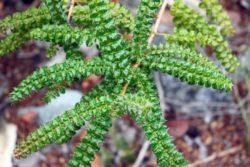
The Christmas Bush (Comocladia dodonaea) is also known as Poison Ash and is a relative of Poison Ivy. It has small, overlapping, spiny leaves that turn red with age. This mix of small red and green leaves, has probably led to its local name, Christmas Bush.
Christmas Bush is a native plant found in South America and the Caribbean.
The active chemical irritant is called urushiol, which is also found in poison Ivy, poison oak, poison sumac, cashew nut shells and in extremely small amounts in mangoes.
Christmas Palm
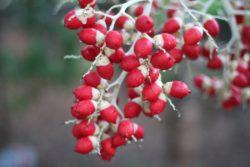
The Christmas Palm, Veitchia merrillii, is so named for its bright red fruits that often mature at Christmas time.
Coconut Palm (Cocos nucifera)
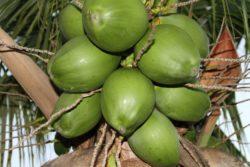
The coconut palm is the symbol of the tropics. Their natural habitat is the area at the top of sand beaches where few other species can grow. In this area a layer of fresh water floats above another layer of salt water that seeps through the sand from the sea. The coconut palm roots seek out this fresh water layer. Although the coconut palm also grows well in good soil, it is more prevalent in sandy environments where there is less competition.
In St. John, the coconut is usually enjoyed while still green and slightly immature, when the nut meat is still soft. In this form they are called jelly nuts. After drinking the coconut water, the soft meat or jelly is eaten with a spoon made from the husk of the coconut. Coconut water mixed with gin is a popular drink around carnival time and is said to have aphrodisiac qualities.
Although the coconut palm is found all over the Caribbean, it is not native to the area. Their exact origin is not known for sure, but they probably originated somewhere in the Pacific Basin.
The coconut is one of the largest seeds in the world. It can float and withstand many days at sea. When it finds a beach, the leaves will sprout before the roots emerge. The coconut can move around with surf and tide until it finds an ideal spot on the beach to grow.
The leaves, or fronds, can be used to thatch roofs or to make mats, baskets and hats.
Coffee
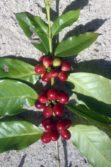
Coffee was one of the first agricultural products to be grown in St. John. Some plants still exist today. The fruits of the St. John coffee bush can make a nice cup of coffee. Learn more about how it’s done in the “St. John Coffee” section on the culture page.
Croton
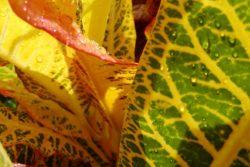
American Cotton
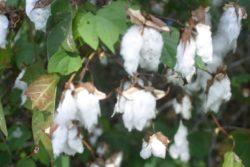
The Tainos, the people that the European explorers encountered on their voyages to the “New World,” grew a variety of cotton with long fibers, from which they wove fabrics and made hammocks. This discovery must have been a great improvement in the European’s quality of life, and now, thanks to the Tainos, people worldwide can enjoy soft, comfortable cotton clothing.
Datura
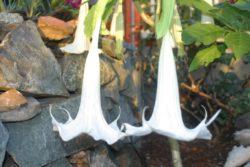
There are several varieties of the Daura plant on St. John.They are plantst that contains the potent and deadly psychoactive alkaloids known as belladonna, henbane and mandrake. These plants have been used for centuries as medicines, poisons and intoxicants, and are often associated with witchcraft, sorcery, obeah, voodoo and shamanism.
Egg Fruit (Pautaria campechiana)
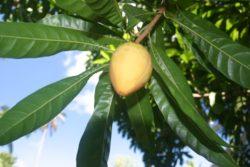
The egg fruit is also so known as Canistel and Yellow Sapote
The pulp of the yellow-skinned egg fruit has the consistency of a hard boiled egg yolk, but with a sweet taste. The shiny brown seed is used in Caribbean crafts
The egg fruit is a good source of carotene, protein and vitamin C.
Fern

Fiddlewood
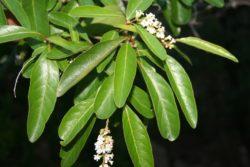
The fiddlewood is a common tree that can be found in both dry forest and moist forest environments. The wood is very dense and has been used on St. John to make furniture and musical instruments.
The flower, which comes out in the spring, has a beautiful sweet aroma that can be quite pronounced during the early morning hours.
Flamboyant
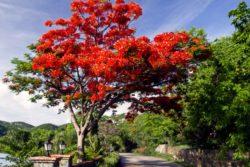
Although not native to the Virgin Islands, the flamboyant can be seen all over St. John including undeveloped hillsides within the Virgin Islands National Park. The Seedpod makes a musical instrument called a shak shak
Frangipani
Plumaria alba
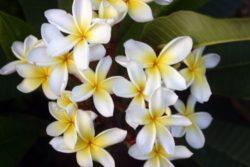
The native or wild frangipani has a smooth bark and long slender leaves. It produces a pleasant aromatic flower that is always white.
Its imported relative, Plumeria rubra, may have pink or white flowers.
Both varieties have soft fat twigs that serve to hold water during dry periods.
Every year their leaves are eaten by a beautiful, large, black and yellow caterpillar with a redhead.
They are called frangipani caterpillars, and after they eat up all the leaves they begin a metamorphosis and eventually become a big dark moth called the sphinx moth.
Guavaberry
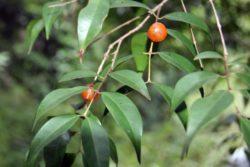
Guavaberries can be purple or orange depending on the tree. Some people prefer one color over the other, but if I close my eyes I cannot tell the difference between the two. I doubt if anyone can.
Guavaberry trees can be identified by their smooth, shiny bark that looks much like the bay rum tree, but with smaller leaves. They usually bear their small purple or orange berries in the late fall or early winter. The berries are prized for their use in guavaberry wine and guavaberry pastries, traditional Virgin Islands Christmas treats.
Hibiscus
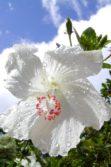
Hot Peppers
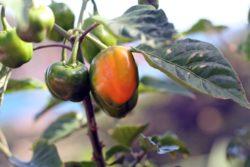
Jacquinea (acquinea berterii)
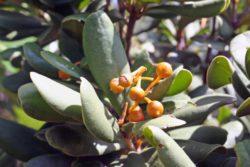
The jacquinea is a slow-growing beautiful native shrub found in dry scrubby locations. Aniamls do not like to eat this bush and as a result it can be found in areas where anamials once grazed.
Kapok (Ceiba pentandra)
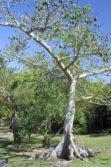
The kapok is known by different names in different parts of the Caribbean. In the BVI it is called the silk cotton tree. Some down islanders call it the jumbie tree.
The kapok can reach heights of over 150 feet and, in hot, wet, and sunny environments, can grow as much as ten feet in a year.
On the Caribbean island of Antigua, an immense 300-year-old kapok tree has become a tourist attraction. There is a large hollow area at the base of the trunk where as many as twenty people can stand completely inside the ancient tree.
On the island of Vieques, there is also a ceiba that has become a tourist attraction as well as time-honored gathering place.
If you want to see a beautiful kapok tree on St. John, one can be found on the Reef Bay Trail. It is well marked by the National Park Service sign quoted above. Remember to avoid the evil Xtabay woman, however, if for some reason you find yourself there after sunset.
Lignum Vitae (Guaiacum officinale)
Lignum vitae means “long life” in Latin, from which comes one of its common names, Tree of Life.
Lignum Vitae is the heaviest and densest wood in the world and will rapidly sink to the bottom when placed in water. It resists rot caused by insects and moisture so effectively that remains of Lignum vitae wood used as posts for dwellings by Taino Indians discovered in Tutu, St. Thomas were dated by carbon dating and found to be over 800 years old. In colonial days this hard, strong, and long-lasting wood was an invaluable construction material.
In backtime Virgin Islands when someone’s problems were especially severe or when someone was carrying an extremely heavy emotional burden it was said that their troubles were “heavier than a Lingy Vitae cross.”
Before the European colonization, which led to the deforestation of St. John, there were many stands of Lignum vitae on the island. They helped to produce a jungle-like canopy over large portions of the island, providing shade for tropical undergrowth.
Lilly
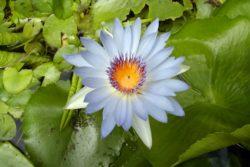
Lime Trees
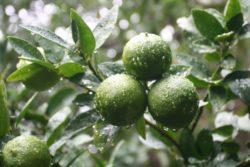
Most lime trees found on St. John are the key lime variety, probably best known as the main ingredient of key lime pie.
Key limes trees can survive the harsh conditions on St. John, but they do particularly well when given water during prolonged dry spells. The limes are picked when green commercially, but left to their own devices they’ll turn yellow and fall off the tree, which gives them added flavor.
Many citrus trees were once planted lower Reef Bay Valley, and some lime trees still remain and one in particular can be found growing right alongside the Reef Bay Trail.
Mampoo
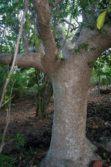
The mampoo is relative of the common bougainvillea. It can be found on shorelines but is more commonly found as elevation increases and coastal scrub lands give way to dry forests. It is often the largest species in the dry forest environment
The trunk of the mampoo holds water enabling the tree enables it to resist prolonged periods of droughts.
Mango
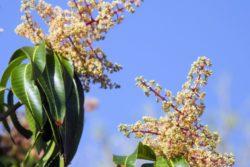
Yellow Maran
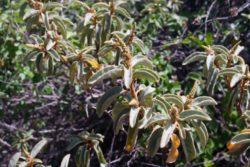
The maran is found in profusion in formerly heavy-grazed areas. They remained because the bush is poisonous to livestock and consequently not consumed by them.
The leaves have been used as pot scrubbing agents. They do a great job! They are organic, biodegradable and leave a fresh sage-like aroma
Maubi (Colubrina elliptical)
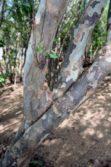
This hardwood dry forest tree is used to make the local drink “maubi,” usually available during carnivals or at local fairs.
Night Blooming Cerius
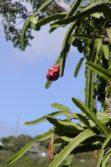
There is a delicious fruit that grows wild on St. John that not many people know about. Old time St. Johnians call it a chickenette; others with roots in the British Virgin Islands and down island call it a strawberry or sometimes a strawberry pear. Latinos call it a pitaya and another common name is dragon fruit.
The pitaya is a red oval-shaped fruit about six inches long, tasting something like a kiwi, but sweeter and juicier. The fruit is produced by the night blooming cereus, the thorny vine-like cactus that you see growing along the ground and over bushes in dense tangled clumps or climbing up tree trunks or dangling down from branches.
The night blooming cereus is also called sweet-scented cactus, vanilla cactus, large-flowered cactus and reina de la noche (queen of the night) in Spanish. It blooms once a year, usually in late summer, and bears the largest flower found on St. John. The flower, which is white with yellow stamens, smells like vanilla and can reach as much as one foot in diameter. It opens up so quickly that you can literally watch it unfold right before your very eyes.
Like other commonly found and often ignored items on St. John, the night blooming cereus fetches a hefty price stateside. The young tender stems and the flowers can be pounded out to make a milky white juice.
Nothing Nut
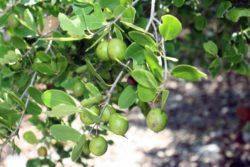
The fruit of the nothing nut is enjoyed by bats. It’s edible but not tasty.
Pineapple
The Virgin Islands pineapple, although smaller than the store-bought Hawaiian variety, is much sweeter – it’s candy!
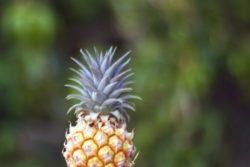
Pinguin
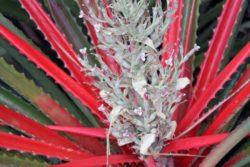
Pinguin is a member of the bromeliad family. They were probably brought to the Virgin Islands by the native Amerindians.
The individual plants grow close together and have numerous barbed spines that stick out every which way. This makes pinguin extremely difficult to pass through. Early European settlers took advantage of this characteristic and used the pinguin as a living fence.
The pinguin is also called false pineapple because of its great resemblance to the true pineapple. It produces a large attractive flower that is followed by a cluster of edible yellow fruits, which have a pleasant and mildly tart taste.
Pistarckle
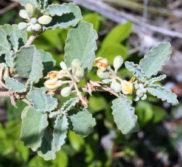
The pistarckle, also known as broom bush, is a relative of the more commonly found maran bush. Like maran and other crotons, the pistarckle is poisonous to livestock and thus remains where grazing has wiped out other species. Because of the nature of the leaves, it has been used to make brooms.
The word, “pistarckle,” was used in the former language of St. John, Dutch Creole, to signify a commotion.
Poui (Tabebuia serratifolia)
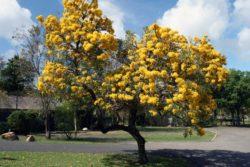
The poui or yellow cedar, blossoms in the spring and when in full bloom is one of the most colorful and dramatic trees to be found on St. John.
The poui tree is the national tree of Brazil.
Some species form a symbiotic relation with ants. Attracted to a sugary secretion produced by the tree, the ants serve to protect the tree from other insects and animals that would otherwise eat the leaves, bark or flowers. The genus name, Tabebuia, comes from the indigenous Brazilian Tupian Indians words for “ants” and “wood.”
The fallen flowers make a beautiful yellow carpet on the ground beneath the tree.
Sage (Lantana involucrata)
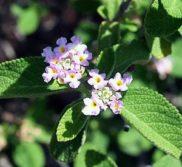
Sage Bush, also known as pink sage, is found in dry areas and owes its survival to being poisonous, i.e. they aren’t eaten by grazing livestock.
Sandbox Tree (Hura Crepitans)
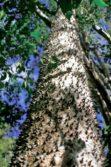
The sandbox tree is recognized by its many dark pointed spines and smooth brown bark. The sharp spines along the trunk have caused it to be called monkey no climb. The white prickle, yellow prickle and kapok have also been called monkey no climb for the same reason.
Another name for this tree is monkey pistol. The tree has beautiful seed pods that look like tangerines made out of wood. When the seed pods are perfectly ripe, the individual segments, which are the separate seeds, burst apart making a sharp cracking sound like a pistol being fired.
The origin of the name sandbox tree was once explained to me by St. John horticulturist, Eleanor Gibney:
“During the Victorian era a necessary desk accessory was something called the sandbox. People kept sand in it to blot ink with. Some enterprising person, upon finding these pods in the West Indies, must have decided that if you got them right before they split open and put a little glue in them, they would stay intact, and they would make perfect little sand holders.”
“There are probably hundreds of them sitting around in the attics of Europe,” she added.
Seagrapes (Cocoloba uvifera)
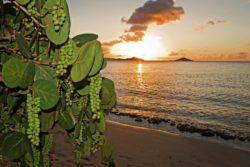
Seagrape tree, Coccoloba uvifera, are commonly found on St. John’s sheltered beaches growing at the edge of the sand. These seagrapes can grow into tall trees some as much as 30 feet high.
Seagrapes can also be found on windy exposed beaches and low hillsides. They adapt to these windy conditions by taking the shape of squat a low lying bushes.
The female sea grape grows grape-like clusters of fruit, which turn purple when they are ripe. They can be eaten plain or made into preserves or wine. You can write on the leaves with a sharp stick or pointed object, a characteristic that led them to be used as playing cards by early setters to the islands.
Sea Purslane (Sesuvium portulacastrum)
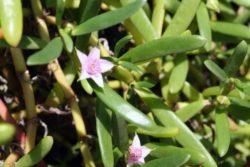
Sea purslane is commonly found on beaches, mangroves and around salt ponds. The stems and fleshy leaves are edible. They have a salty flavor and are used in salads. In various parts of Asia, sea purslane is cultivated and sold in markets.
Sensitive Plant (Mimosa pudica)
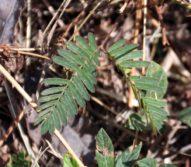
Starfruit
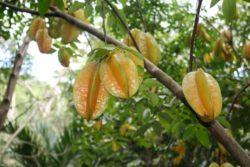
The starfruit, also known as cambola, begins as a green fruit and later changes color to yellow or yellow-orange. The fruit can be eaten either way. It is mildly sweet and high in vitamin C.
Starfruit trees can be found on St. John as well as in the rest of the Caribbean. It also grows in Asia, Central and South America, Florida and Hawaii.
Stinging Nettle (Urtica dioica)
While pulling out some weeds on my ground, I noticed a stingy itchy sensation, which I quickly attributed to a low-lying plant that I thought was a more benign kind of vine, which was, in fact, stinging nettle.
Over to the digital microscope it went and here’s what I saw:
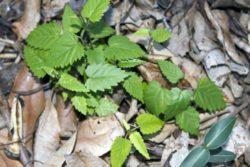
Notice the needle-like fibers. They act like hypodermic needles injecting histamine into the skin, which itches and burns. It effects some worse than others.
Treatments include ointments containing antihistamine and hydro cortisone as well as a host of natural remedies. Me, I just left it alone and it soon stopped hurting.
Stinging nettle has been used for food, teas, medicines and fiber.
Sugar Apple (Annona squamosa)
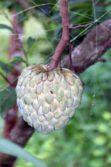
Sweet Lime (Triphasia trifolia)
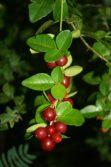
The Sweet Lime or Limeberry is a plant with thorns that can be unfriendly to hikers when left to grow out over the trail. The limeberry produces a fragrant flower and bears an edible, red, berry-like fruit, with an acidic, lime flavored flesh. The limeberry is used locally in making jams and jellies
Tamarind (Tamarindus indica)
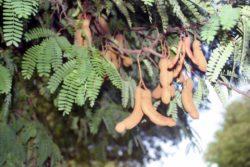
Tamarind trees can usually be found along roadsides in dry forest areas. These large trees produce a tart, yet pleasant tasting, fruit that is about three inches long and looks like a brown seed pod.
They can be eaten raw or made into drinks or preserves; tamarind drink being a local favorite. Tamarinds are often used in Indian cooking and are an important ingredient in the popular Lea and Perrins Worcestershire Sauce.
Torch Wood (Amyris balsamifera)
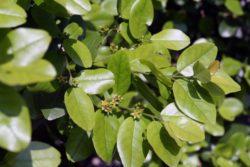
The torch wood tree is commonly found in St. John’s dry forest environment.
Because of is high oil content, it has been used as a candle, torch or flamboux.
The oil can be distilled to make amyris essential oil commonly referred to as West Indian Sandalwood oil.
Wild Tamarind (Leucaena leucocephala, Leucaena, tantan)
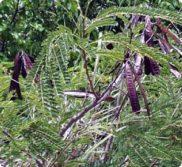
I hate wild tamarind. They’re ugly, untidy and unruly. They spread rampantly and take over the place. They’re prejudiced and intolerant. They grow close together and won’t let any other plants live in their neighborhood.
They’re resilient and tenacious. Their sturdy taproot goes straight down into the earth and holds on tight. They can withstand drought, flood and even come back after a fire. There are no insects, predators or diseases that can do them any significant harm.
They’re hard to get rid of. If you cut them down, they’ll grow right back. If you try and pull out the small one, you’d better have a lot of time and a lot of patience. If you try and dig out the big ones, you’d better have a good hoe-pick and a strong back.
On St. John, wild tamarinds thrive wherever land is disturbed. You’ll see them on roadsides, along trails, on land cleared for construction or wherever hurricanes or severe storms have blown down trees in the forest.
Even though I hate them, and other St. John gardeners will probably share my feelings, they are not without redeeming value. They control erosion, covering bare land rapidly and effectively.
They are also nitrogen fixing. This means that, unlike most plants that use up organic nitrogen compounds from the soil, eventually depleting it, wild tamarinds actually add nitrogen compounds to the soil by taking nitrogen from the air and changing it into organic nitrogen compounds that enrich the earth.
West Indian Locust
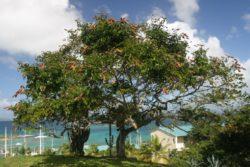
The West Indian locust can be found throughout the Caribbean, Mexico, and Central and South America. On St. John it thrives in moist forest regions such as Reef Bay and Bordeaux Mountain.
Hikers on the Reef Bay Trail will pass by an excellent specimen of the stinking toe tree, which is identified by a National Park Service information sign.
Stinking Toe Tree
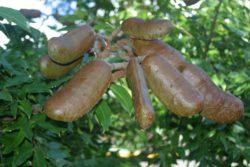
Despite the unappealing name, and an equally unappealing odor, many Virgin Islanders, especially children, have been known to enjoy the sweet taste of the stinking toe fruit. In El Salvador the stinking toe is actually sold in food markets, but is known by a more appetizing name, copinol.
Have you ever gone to the dentist and needed to have a large cavity filled? According to Virgin Island’s dentist the late Dr. Howard Haynes, after drilling, most cavities are treated with a sealant before they are filled. The sealant prevents discoloration, absorption of the filling material and possible infection. It also desensitizes the tooth and “makes people feel better when the cavity is close to the nerve,” Dr. Haynes said. The sealant most often used is called copalite and comes from, you guessed it, copal, the hardened sap produced by the stinking toe tree.
Stinking toe, scientifically named, Hymenaea courbaril, is also used extensively in traditional folk medicine. According to the Weed Women of the St. George Village Botanical Gardens on St. Croix, the smoke from copal resin helps alleviate headaches and rheumatism.
Little and Wadsworth in their book, Common Trees of Puerto Rico and the Virgin Islands, mention that the bark of old locust trees could be removed in long thick sheets. This attribute of the locust led it to be used by the indigenous peoples of the Amazon region to make large canoes capable of holding twenty-five to thirty people. The sheets of bark were sewn together in the form of a canoe. The seams were waterproofed with resin and wooden crosspieces were fitted to provide strength and hold the shape.
White Cedar (Tabebuia heterophylla)
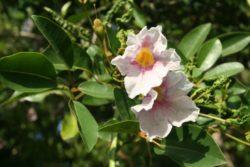
The white cedar, also called pink cedar and pink poui, produces a beautiful flower that carpets the ground below when they fall. The hard wood of this tree has been used on St. John as well as througout the US and British Virgin Islands for the constructon of native boats and sloops.
White Manjack
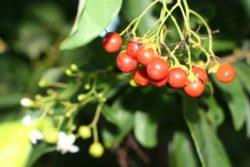
The White Manjack is a commonnly found tree in St. John’s dry forest environment. White flowers form in the spring followed by red berries that can be used to make a glue. The berries are also used by Rastafarians as a hair conditioner for their dreadlocks.
